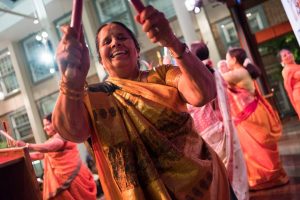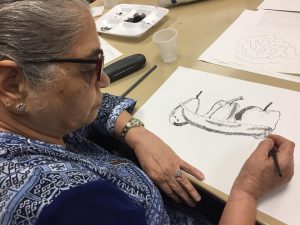This post originally appeared on the India Home blog.
 It’s India Independence Day, 2017, and at the celebration being held at Queens Borough Hall in Queens, NY, the young announcer invites the next act to come up on stage. Ten women from India Home file in and start dancing, their bright white, orange and red saris billowing, their feet making dexterous patterns to the insistently upbeat music. The scene is remarkable not for the fact that there are Indian dancers in Queens, but because the women swaying on stage are all between 65 and 85 years old.
It’s India Independence Day, 2017, and at the celebration being held at Queens Borough Hall in Queens, NY, the young announcer invites the next act to come up on stage. Ten women from India Home file in and start dancing, their bright white, orange and red saris billowing, their feet making dexterous patterns to the insistently upbeat music. The scene is remarkable not for the fact that there are Indian dancers in Queens, but because the women swaying on stage are all between 65 and 85 years old.
It is no coincidence that these women are so fit and vigorous. They have been dancing for years and are living proof of a growing body of research that links participatory arts activities to an increase in the health, well being, and quality of life in aging adults. One study of adults aged 60 and over suggested “health benefits of dance for older adults such as improved cognition and attention, posture and balance, and hand/motor skills in comparison to the control group. ” And it’s not just dance. CreateEquity, a think tank and online publication “investigating the most important issues in the arts” has analyzed extensive research that shows that taking part in arts related activity benefits older adults in myriad ways.
- Singing improves mental health and subjective wellbeing (i.e., perceived quality of life)
- Playing a musical instrument has myriad positive effects, including dementia risk reduction
- Visual arts practice generates increases in social engagement, psychological health and self-esteem
In 2006, the National Endowment for the Arts published the results of a landmark multisite (Washington DC metro area, Brooklyn and San Francisco) national studyundertaken with the aim of “measuring the impact of professionally conducted community based cultural programs on the general health, mental health, and social activities of older persons, age 65 and older.” Referred to as the Creativity and Aging Study, it was the first effort in this area to use an experimental design and a control group to study 300 participants in the 65-103 age range.
The results were striking. The 150 older adults who were involved in weekly participatory art programs reported: (A) better health, fewer doctor visits, and less medication usage; (B) more positive responses on the mental health measures; (C) more involvement in overall activities. The results pointed to the powerful positive effects of community-based programs run by professional artists, now known as Creative Aging Programs.
What in the world is Creative Aging?
Lifetime Arts, a nonprofit organization is very clear on what Creative Aging is not: “it’s not about making macaroni necklaces.” Creative Aging then according to Lifetime Arts is ” the practice of engaging older adults in participatory, professionally run arts programs with a focus on social engagement and skills mastery.” These are programs based in the belief that individuals do not stop growing or learning at any age. They are interventions, and disruptions that help older adults free themselves from traditional and limiting preconceptions about aging and decline and help them discover new possibilities, and new skills.
Learning New Ways of Creative Expression
At our Sunnyside Center, Creative Aging classes include photography and drawing workshops, recreational dance, as well as poetry and memoir classes.
 Starting in November, a 9-week long drawing workshop, run by Ebenezer Singh, a professional artist and funded through a grant from Lifetime Arts, is introducing elders to advanced drawing using a wide range of materials such as India Ink, carbon pencil, watercolors. The classes also include conversations about historical and contemporary art, and introduces famous Indian artists, thus adding cultural sensitivity to the mix. While some of the participants were unsure of their artistic skills in the beginning, their confidence grows day by day. “I didn’t know I could draw like this,” Shobana Shah said in a recent class. “I’m enjoying learning this very much.”
Starting in November, a 9-week long drawing workshop, run by Ebenezer Singh, a professional artist and funded through a grant from Lifetime Arts, is introducing elders to advanced drawing using a wide range of materials such as India Ink, carbon pencil, watercolors. The classes also include conversations about historical and contemporary art, and introduces famous Indian artists, thus adding cultural sensitivity to the mix. While some of the participants were unsure of their artistic skills in the beginning, their confidence grows day by day. “I didn’t know I could draw like this,” Shobana Shah said in a recent class. “I’m enjoying learning this very much.”
In a paper published in the journal Arts and Health in 2012, lead researcher Nikky Greer documented improvements in both mental health and social wellbeing, “through increased social engagement, self-awareness, empowerment, and a sense of calm and relaxation.”
Our Sunnyside participants are so enthusiastic about the classes, they take photos of their work with their cell phones, so they can go home and practice before the next week rolls around.
Writing Workshops
Meanwhile, our Desi Senior Center, India Home’s largest center in Jamaica, Queens, offers writing workshops to older Muslim men and women from Bangladesh thanks to a grant from Poets and Writers.
In Beyond Nostalgia: Aging and Life Story Writing, author Ruth E Ray explains why writing and sharing life stories in groups is valuable from a developmental perspective for older adults. Writing and sharing life stories allows them to not only make public the methods by which they make meaning of their own lives, but also “seeing and hearing others” helps them to understand that they are not alone in that meaning-making process.
At our Desi Senior Center, the ten week memoir course meets for an hour and a half every week, and families and friends are invited to attend the final reading. One recent Thursday, participants were encouraged by their instructor, Sabbin Akhter, a published writer herself, to read aloud from short memoir pieces that the elders had written to illustrate commonly used proverbs in Bangladesh. The readings were lively, full of dialogue and imagery. Lyrical descriptions of trees, cows, fields and the seasons evoked the villages from which the elders had migrated. As each writer in the circle finished reading their piece, the others applauded, shouting encouragement. “You get the first and second prize,” one grandmother told another, clapping her hands in delight. The sense of camaraderie and friendliness between the budding writers is palpable.
Our Approach to Creative Aging is Evolving
India Home is committed to intentionally engaging Creative Aging as a targeted program and our approach continues to evolve. Our aim, as it is with most of our programming, is to focus on creative activities that are culturally appropriate. While it is sometimes challenging to find artists who speak South Asian languages or can offer culturally appropriate art activities, we persist because culturally relevant programming is the most effective way to reach the seniors in our communities.
Still, watching our older adults laugh over a wonderful memory in their notebook, or admire a still life of colorful fruit that they created in an afternoon, or dance on a stage at the Rubin Museum, are reasons enough for us to constantly innovate and continue to offer these programs.
The opinions expressed in this article are those of the author and do not necessarily reflect those of the Diverse Elders Coalition.

